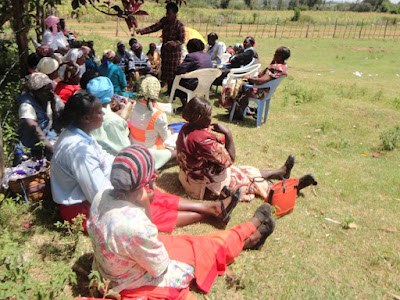By Samwel Nyaga
Integrated pest
management is important in keeping pest populations below economically
injurious levels. Speaking during a six days Conservation Agriculture Training
of Trainer (TOT) course held on August 24-29, 2015 at Olympia Hotel in Nyahururu,
Mr. Gichuki Hutu, Laikipia West Master Trainer said that dependence on a single
pest management method would have undesirable effects on crop production.
He said that farmers
should recognize that there is no “cure-all” in pest control and they should
determine and correct the cause of the pest problem by understanding pest
biology and ecology.
The County Government of
Laikipia in collaboration with Food and Agriculture Organization (FAO) of the
United Nations organized the six days course.
 |
| Farmers being shown how to use Actellic to control weavils |
“Understanding crop growth and development is
an underlying principle of integrated pest management. You need to know how to
grow a healthy crop, when it is susceptible to pest damage and stress and how
the environment affects pest and crop development,” said Mr. Hutu.
He said that the basic principles
of intergraded pest management are prevention, observation, and intervention. He
noted that integrated pest management is not static due to emergence of new
pests, strains, shift in weed species and pesticide resistance.
The general aim of
prevention is to reduce initial severity or buildup of pest infestation. This
includes: Growing crops and choosing varieties appropriate for the location; sound
rotations; use of herbicide tolerant or pest resistant crops; taking steps to
encourage beneficial insects and animals; use of sowing and undersown mixed
crops; careful harvesting; good Hygiene; and seed cleaning and storage.
Observation involves
determining when and what action to take based on all available information
like crop monitoring for pest and damage thresholds. Use of decision support
systems to interpret collected data, sound record keeping, and advice and
support from experts is also important.
Interventions aim to
reduce the effects of economically damaging pest populations, weeds, and
disease to acceptable levels through mechanical, chemical, and biological
measures. He urged farmers to use pesticides only when the benefits outweigh
the risks.
Benefits of an integrated
pest management program include: increased consumer confidence in the quality
of food; increased crop profitability especially where presently pest control
is poorly used or ineffectual; stable and reliable yields; reduced pest
infestations; sustainable agricultural production; protection of environment
through elimination of unnecessary pesticide applications; and reduced risk of
crop loss by pests.
 |
| Farmers being traineed on best agricultural practices |
Each pest control
technique must not only be environmentally sound but should be compatible with
producers objectives like being economically viable, effective, understandable and
able to be implemented in stages.
He said that it is
possible to manipulate the environment to the crop’s advantage by utilizing all
suitable pest management tactics like cultural, mechanical, sanitary, natural,
biological, and host plant resistance method.
He noted that cultural
control effectiveness is through agronomic practices designed to optimize
growing conditions for the crops in order to create unfavorable conditions for
the pest.
Sanitary control helps to
avoid introducing a pest into a field. Cleaning field equipment, planting
certified seeds and quarantines can ensure sanitary control.
He said that host plant
resistance is by manipulating the crop to withstand or tolerate pests through
natural breeding method and use of genetically modified plants.
Pest is an organism with
characteristics that farmers see as damaging or unwanted, as it harms
agriculture through feeding on crops or parasitizing livestock.





















